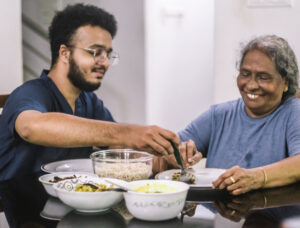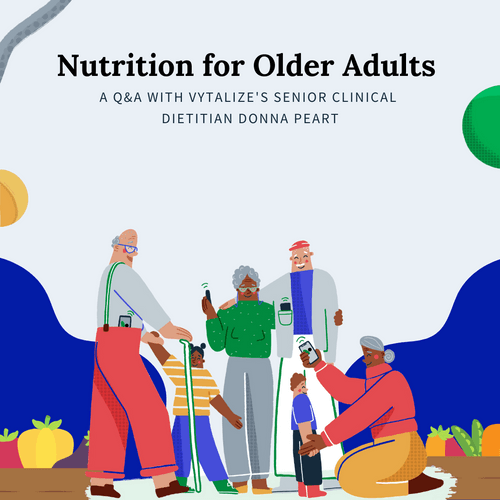 According to the Dietary Guidelines for Americans, 2020-2025, older adults tend to exceed dietary limits for added sugar, saturated fats and sodium. At Vytalize Health, we believe in being proactive than reactive. That is why we offer additional support that includes nutritional counseling to Vytalize partner providers and their patients in an effort to improve their quality of life.
According to the Dietary Guidelines for Americans, 2020-2025, older adults tend to exceed dietary limits for added sugar, saturated fats and sodium. At Vytalize Health, we believe in being proactive than reactive. That is why we offer additional support that includes nutritional counseling to Vytalize partner providers and their patients in an effort to improve their quality of life.
Vytalize’s Senior Clinical Dietitian, Donna Peart tells us how she engages with patients in her role and ensures they are eating nutrient-dense foods that allow them to live better and healthier lives.
How do you become engaged in patient care as the nutritionist / dietitian?
I receive consults through our Vytalize Case Managers and Nurse Practitioners. The patients I see have at least two chronic conditions, such as diabetes, prediabetes, BMI>30 or <18.5. Physicians enroll their patients into our Priority Care Program, which provides supplemental clinical and social services, and are aware that nutritional services are an option available to them. Both the physician and patient need to approve the nutrition consult before it is sent to me.
Are there identifiers or factors that providers look for before they send a patient your way?
The patient’s chronic health conditions are the identifiers; these include diabetes, hypertension, obesity, pre-diabetes, hyperlipidemia, cancer, failure to thrive, irritable bowel syndrome (IBS) and food allergies.
How often do you meet with the patient and/or provider?
After an initial telephonic consult – which is our longest session together – I typically meet with each patient one-on-one once a month. I have access to the patient’s records and Case Management notes, which ensures that everyone on the patient’s care team is on the same page. These notes also give me a good sense of what the patient’s current issues are, and helps the patient know we are approaching their care as a team. I can see a patient more often if they feel they need more support and accountability. The notes and patient education resources I enter in the chart give the case manager (CM) the opportunity to check in on the patient’s progress with their recommended meal plan, as well as their overall medical plan. The patient receives customized nutrition information either in the mail or via email based on their preferences. We have wonderful nutrition resources from overarching diet information based on disease state to recipes, customized meal plans, and individualized key points discussed. Patients usually get a combination of all of these based on their readiness and prior knowledge.
How does your relationship with the patients you work with evolve over time?
 As my relationship with a patient grows and evolves, I can dive deeper into changes. Sometimes, we can only change one thing at a time. A mutually agreed upon goal might look like avoiding eating breakfast meat five out of seven days. We ensure that the patient is an active participant in the problem-solving progress, as ultimately it is up to them. Their goals should be achievable, so the patient feels empowered to move forward. Once they achieve one goal, we move on to the next one.
As my relationship with a patient grows and evolves, I can dive deeper into changes. Sometimes, we can only change one thing at a time. A mutually agreed upon goal might look like avoiding eating breakfast meat five out of seven days. We ensure that the patient is an active participant in the problem-solving progress, as ultimately it is up to them. Their goals should be achievable, so the patient feels empowered to move forward. Once they achieve one goal, we move on to the next one.
Handing a patient a sheet on a Low Sodium Diet is likely not going to be successful. But, when we are talking and the patient is in the kitchen and checks the label on their canned soups and sees 600 mg Sodium per serving… now that is impactful!
As our relationship grows, I can ask the patient how they changed their shopping habits and how that worked for them, and give them positive reinforcement for that. And, when they see their blood pressure go down, they see the direct cause and effect of lowering their Sodium intake.
Other than the EHR and Care Management notes, how else do you communicate back with the patient’s care team to ensure they know what’s going on with the patients you work with?
Vytalize has recurring monthly meetings with our physician partners and practices, and our care management groups. Sometimes I’ll attend these meetings and relay any pertinent information, so they are kept up to date. Physicians also receive monthly care plan reports, which would include my progress notes on the patients I work with.
How much of a correlation does health have with nutrition? How closely are the two intertwined and how much does one impact the other?
 One cannot exist without the other – food is medicine. You can fight inflammation, which is thought to be the base cause of all chronic disease with your food choices. By having a diet rich in phytonutrients and antioxidants, you can fight disease at the cellular level. In other words, you can stop that cell from mutating from a healthy cell to a cancer cell that spreads.
One cannot exist without the other – food is medicine. You can fight inflammation, which is thought to be the base cause of all chronic disease with your food choices. By having a diet rich in phytonutrients and antioxidants, you can fight disease at the cellular level. In other words, you can stop that cell from mutating from a healthy cell to a cancer cell that spreads.
Additionally, your body cannot repair itself or function correctly without the right foods. Foods that contain vitamins and minerals – as well as the macronutrients necessary to repair tissue, skin, and infections – are necessary on all fronts. If you are an athlete training for a marathon, which is an inflammatory process that food repairs, your muscles are breaking down and need to be built back up and repaired with needed protein, carbohydrates, and antioxidants.
The same could be said with the aging process. Adequate calories, protein and carbohydrates are necessary to keep the body going. With enough calories, but not enough protein, you will not be retaining muscle mass. Conversely, without enough calories, your body will break down its own protein (muscles). This becomes a problem because people lose muscle at a more rapid rate as they age. Nutrition partnered with weight-bearing exercise can help reverse that to some degree.
What are some common themes and things you notice with the patients you work with?
I often notice patients do not have the energy to bother with making food for themselves if they live alone, which leads to reliance on more processed foods, or tea and toast for supper. I also notice nutrient and protein-poor diets high in refined carbohydrates. Many of the patients I see also rely on takeout and fast foods because of convenience, which are often very high in sodium and fat content.
Additionally, when it comes to grocery shopping, I find that many patients aren’t paying attention to nutrition labels for sodium content. Elderly patients often do not want to be a bother to anyone else, so they try to make the easiest meals they can, which rarely provide nutrients needed to stay healthy – and often exacerbates their health conditions.
The last common theme I see is dehydration. If a patient has physical mobility issues, the last thing they want to do is get up and go to the restroom all the time. To avoid this, they minimize their fluid intake. However, this is detrimental on many fronts, leading to kidney issues, urinary tract infections, headaches, and lethargy.
What are some unique nutritional needs or risk factors in older adults?
- Osteoporosis, diabetes, heart disease, blood pressure issues, dental issues, obesity, and failure to thrive
- Fatigue and pain
- The need to have nutrient-dense foods as nutrient absorption diminishes with age
- Diminished appetite, but not the desire for junk food
- Chewing and swallowing difficulties
- Dehydration
- Not meeting protein needs
- Skipping meals
What are common barriers senior patients face?

- Living arrangements like living alone
- An inability to get around physically
- Limited income
- Medication interactions
- Adapting dietary needs to their traditions and culture
- Fear of being a burden
- Isolation and loneliness
- Depression and anxiety
- Memory issues
- Reliance on family or home health aides for meals and losing autonomy.
How can senior patients overcome these barriers?
- Prepare their environment with healthy foods to set themselves up for success
- Cook when they are feeling strong – even if that means making a meal early in the day and saving it to eat later
- Look for “sparks” and inspiration that encourage them to feel that they can make a difference in their health
- Increase nutrient density (for example: adding chopped spinach or diced veggies into a soup)
- Make healthy snack options more visible (for example: replace a candy bowl with a fruit bowl, or move junk food to a higher shelf and healthier options to eye level for easier access)
- Hydrate! Have a nice water bottle and add fruit to it, or drink a seltzer water or herbal tea
- Always include the patient in meal preparation at whatever level they can participate in
How can caregivers encourage senior patients to adhere to nutritional guidelines and diets?
- Find out who in the household does the shopping and cooking
- Learn about the patient’s dietary needs
- Consider if the patient is adhering to their diet and is being honest with their physician(s)
- Consider any limitations like food insecurity, issues with cooking facilities and difficulty standing to prepare meals
- Explain in plain language how looking at labels on foods can really help with the patient’s chronic disease condition (for example: sodium’s impact on water retention or sugar’s impact on diabetes)
- Explain the consequences of dehydration (urinary tract infections, confusion, lethargy, kidney issues, leg cramps, etc.)
- Empower the patient to make the best choices they can. Instead of telling the patient “You can’t have this or that,” give them a choice. People often surprise themselves with what they can achieve!
- Focus on one thing at a time. For example, meal timing. A patient with diabetes might skip meals, so before talking about what they should be eating at each meal help them understand the importance of having meals every 3-4 hours. Focus on what that meal looks like once they are consistently having three meals.
Do you have a favorite healthy recipe or two you can share?
- Lemony Roasted Chicken, Carrots and Chickpeas
- Blueberry Overnight Oats
Does a patient’s level of physical activity influence the recommendations that you make?
Absolutely! The more active the patient is, the more likely it is that the patient will have healthier habits. Someone active will need more water and have a little more leniency with snacks. Someone with diabetes will need to be sure to have a meal an hour or so before exercise and carry snacks with them for possible low blood sugar reactions. Additionally, patients on hypertension medications often do not get their heart rate up to a working zone, so they need to know to pay attention to perceived exertion and not their heart rate. The more activity someone gets, the more calories someone burns – but the food consumed still needs to be nutrient-dense!
How can physicians engage with you and your team for their patients’ nutrition and dietary needs?
Physicians can ask their Case Manager to send a consult to the Vytalize Registered Dietitian. The patient referred must be enrolled in Priority Care for me to be able to see them. If the patient is in Home Care, I can partner with their Nurse Practitioner on any needed information.
To learn how Vytalize’s nutritional counseling can benefit your patients, contact us today!






